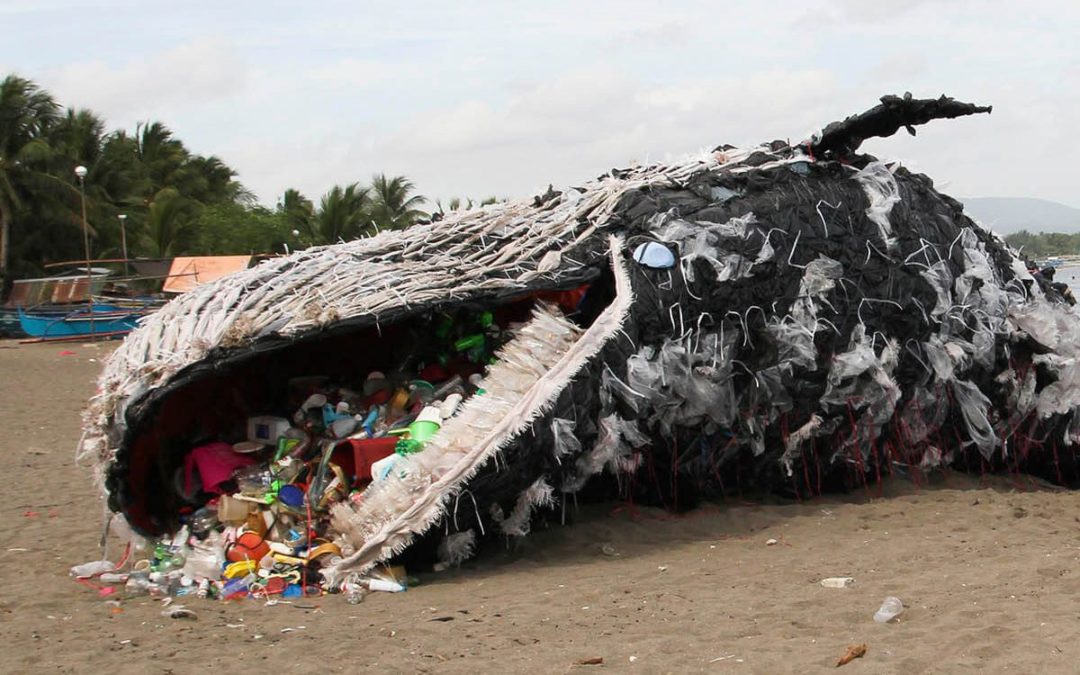I recently read a 2019 report by the World Wildlife Fund for Nature on the production and disposal of plastics (Solving Plastic Pollution Through Accountability report) and was naturally horrified by the stats and impacts, even though I had been aware of the pernicious effects of microplastics on wildlife and throughout the food chain. From the plastic islands floating in the north-east Pacific Ocean to the plastic blockages in the guts of dead whales to plastics in our waterways and soils, the threat from them is significant and growing.
In some ways plastic pollution is a more immediate and widespread threat than most other environmental threats except perhaps climate collapse. Before I get onto the symbolic meaning of this growing threat, let’s consider some stats that are difficult to comprehend yet provide the scale of the problem we face and have created since the 1950s:
- Every human is ingesting and/or breathing in around 5 grams on average or 2,000 particles of plastic each and every week (the weight of a credit card).
- Many of these particles are laced with chemicals that are known to be carcinogenic or hormone disruptors with known and unknown health consequences
- Over 1,000,000 plastic bottles and 1,400,000,000 plastic bags are being produced each and every day, mostly single use plastics being sent to tips, incinerators and waterways
- 53 kilograms of plastic is being produced (2016) for each person on the planet
- Globally, over 240 wildlife species have ingested plastic often resulting in internal injuries and death
- Around 8,000,000,000 kilograms of plastic is disposed of into the oceans every year, killing wildlife and breaking down into micro- and nano-plastics to be ingested by fishes and other creatures that form part of our food chain
- Only 2% of plastics produced in 2013 were effectively recycled and this percentage is likely to have reduced since 2018
- Global plastics production and incineration currently creates the CO2 pollution equivalent to 189 coal plants. By 2050, that’s expected to more than triple, to the equivalent of 615 coal plants.
Of the six trillion kilograms of plastic waste produced since 1950, nearly all of it has found its way into the oceans, soils, ecosystems, foods and animals, including humans. Plastic or rather its petrochemical constituents are found throughout the food chain and are hidden throughout our body. We are destroying life and undermining our own health with our need for cheap, convenient packaging and production. While the Corona virus pandemic swamps the news, of much greater concern is the plastic pandemic that has swept the globe since the 1950s.
Plastics are made from materials such as cellulose, coal, natural gas, salt and crude oil (around 5% of global oil production goes into plastic production) and through a polymerisation or polycondensation process to produce solid, malleable products mostly for packaging, toys, diapers, components for vehicles, engines and a variety of consumer products. It is everywhere and has become an integral part of our economy, way of life and our consumption.
The conversion of natural products into artificial, toxic products is a symptom of our technology driven consumption patterns that is driven by increasing lifestyle expectations, patterns and desire for convenience. Despite the increasing environmental awareness in the community, we cannot break our addiction to excess consumption and the plastics that go with this.
This growing consumption of plastic in our foods, air and waters is leading to increasing illness and deaths from cancers and other diseases. With our increasing psychological, emotional and spiritual disconnect from nature over several centuries and particularly since the advent of mass plastic production and consumerism in the 1960s, we have become malleable vehicles for our life destroying economic system. Even if we are good environmental citizens and care about the natural world, we remain players in an economic system that is destroying more and more life, and ultimately undermining our civilisation.
Plastics in all of its manifestations symbolises the toxicity of our way of life so dependent on fossil fuel use, convenience and disconnect from the consequences of our actions. They symbolise the artificiality of our modern life and its deadly impacts. The fact that all of us, from babies to the elderly are infected with plastics, metals, pesticides and many other toxins is a blight on our civilisational ‘progress’. This toxic stew we take into our bodies is largely ignored by the mainstream media and so most people are not aware or not concerned sufficiently to look for alternative products.
I am the first to admit that I am surrounded by plastics and it is challenging to not to purchase products not wrapped or packaged in plastic. I try to avoid plastic bags for grocery and vegetable shopping and minimise my consumption of clothes and technology. But I cannot avoid the use of plastics in my car, the products used in my home and computer, the food systems that allow me to purchase food and every part of my life, including the gym equipment I use to stay healthy.
Apart from minimising consumption and eating healthily using organic and home-grown vegies, my focus is to be as healthy as I can to allow my immune system the best chance of fighting toxic invaders. This is supplemented with dealing with negative states such as sadness and frustration and anger by contemplative and NatureConnect practices. I believe in the power of the heart, mind and spirit, with nature’s healing hand, to create the healthy psychological landscape to deal with the degradation of the external.

